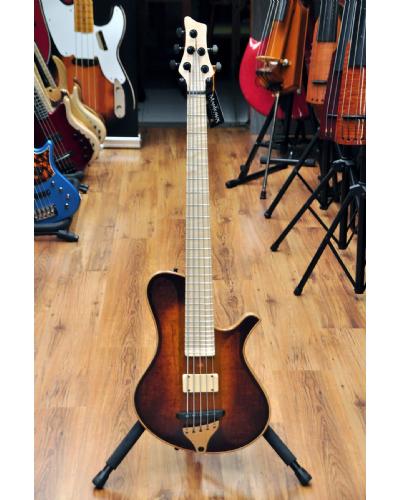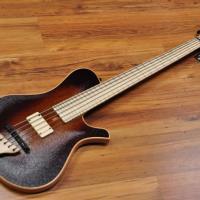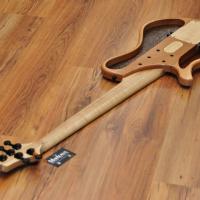Gerald Marleaux makes fine basses at the highest level! He is also a busy spirit who doesn't rest on his laurels, but is constantly working on new bass models.
Surprisingly, the impetus for his latest model came from the Clausthal University of Technology, or rather the “Institute for Polymer and Plastics” (PuK for short) located there. One of PuK's main research areas is natural fiber-reinforced plastics, and the team approached Gerald Marleaux with the question of whether such a material could also be used in instrument making. This question awakened Gerald Marleaux's “inner Daniel Gearhead,” whose first thought was an acoustic bass with a fiberboard top. But everything was to turn out completely differently! After an intensive development period of two years, which was made possible not least by funding for the project from the Federal Ministry of Economics, a completely new electric bass model from Marleaux finally saw the light of day: Spock!
This is a medium-scale five-string that, on the one hand, surprises with a very individual, futuristic design, but on the other hand, according to Gerald Marleaux, from a sound point of view it is definitely inspired by vintage classics, such as the Höfner basses! We will find out in this test whether the symbiosis was successful, because Gerald Marleaux beamed a Spock into our test laboratory before the official presentation at this year's "Guitar Summit" in Mannheim, so that we can make a real precision landing with this test! Thank you for that, dear Gerald! Marleaux Spock – not a bass like any other!
The Marleaux Spock is a very maneuverable and extremely light bass, which is partly due to the short 32-inch scale length and, to a much greater extent, to the special construction, which ultimately turned out to be the best solution for Gerald Marleaux after numerous tests . From the front, the Spock basically looks like a solid-body electric bass that is roughly the shape of the popular Marleaux M-Bass and has a curved and textured top. However, behind the “structured wallpaper” there is no ordinary body, but a kind of frame construction with curved side parts and an approximately 11 cm wide block in the middle made from swamp ash. You could also describe the Spock as a flat hollow-body bass without a bottom (or back). Be that as it may, the basic construction is made of swamp ash.
New approaches to material! The clearly arched ceiling in the frame construction is - as already described in the introduction - the actual reason for the birth of the youngest Marleaux offspring. It consists of a special composite material that is manufactured using a vacuum process (i.e. with negative pressure) from flax and synthetic resin (natural-based polymer). In principle, other fibers such as hemp or linen can also be used, but flax was chosen for the test Spock. This fabric structure of the fiber composite can be clearly seen and felt and therefore gives the Marleaux Spock a very special look and feel. The whole construction also seems very stable, even though the top is only about 1mm thick and weighs extremely little - so the Spock doesn't have to be handled with more delicate hands than a normal semi-acoustic bass. For an attractive look, the ceiling was given a satin finish in the “Tea Burst”color. The ceiling can of course also be painted in other colors. According to Gerald Marleaux, other materials, such as a T-shirt, could even be laminated, making highly individual designs possible. Gerald is per se very open to crazy ideas, as long as they can be implemented without any problems and do not negatively affect the function.
The neck construction, which is bolted to the “body” at five points, is perhaps the most conventional part of the new Spock. It consists of three parts of maple, separated from each other with thin, dark veneers. Rosewood is also used for the fingerboard, which accommodates a whopping 28 (!) frets as well as an additional zero fret.
The Spock can only be played in a relaxed manner up to the 24th fret, but for stability reasons the neck had to be a little longer so that there was still room for additional frets. To ensure a clean look, there are only markings for layer orientation on the flank in the form of small dots.
The strings finally run over a saddle that is only used to guide the strings to the Marleaux-typical compact and slightly backwards angled headstock. This was embellished with a stylish maple glue and houses the five tuning machines of the Marleaux Spock. Encapsulated black models from Schaller, which are equipped with small wings, are used.
The tuners work extremely precisely and run very smoothly, so that operation is very comfortable despite the small blades. However, the tuning mechanisms are the only conventional hardware parts on the Spock, as Gerald Marleaux had to develop and manufacture the remaining components from scratch due to the bass's extraordinary design features.
Amazing bridge construction! The elaborate bridge construction is made up of the tailpiece and the actual bridge, similar to a double bass. The tailpiece is made of maple and has five openings into which the string ends can be easily hung. There is also a metal plate inside the tailpiece, which ensures sufficient stability. Upon close inspection, you can also see that the tailpiece is made of two pieces of maple. The strings run from the tailpiece over the actual bridge, which consists of a narrow ebony chassis and a metal bridge sitting on top. As is well known, for many semi-acoustic or acoustic instruments, such bridges are often only adjustable in height as a whole. However, Gerald Marleaux was looking for a solution for the Spock in which each string could be adjusted individually. The implementation is really ingenious and at the same time very minimalistic, in my opinion: Each string sits on two small screws that can be adjusted vertically for the string position and horizontally for the intonation with a small Allen key. Well, it can be that easy! The rough adjustment of the bridge is carried out using two larger Allen screws, which are accessible via the electronics compartment on the back. As a rule, you won't have to change anything here, because Gerald Marleaux will of course personally take care of the correct basic setting of the bridge during setup before delivery!
This brings us to the pickup and electronic equipment of the medium-scale five-stringer from Marleaux, which is much more extensive than you would expect at first glance. On the front you can only see a pickup, which was installed in the middle between the end of the fingerboard and the bridge. This is a Marleaux/Häussel humbucker that sits in a stylish maple wooden case.
All of the Spock's electronics, including the associated controls and switches, are located on the back of the bass. Gerald Marleaux has milled out an electronics compartment in the middle block in which the Marleaux BC-3 preamp can fit. The controls are located on the two side surfaces of the screwed-on maple cover. At the top we find the volume control, the passive tone panel, and finally a small switch with which the coils of the humbucker can be switched in parallel, series or in single coil operation (rear coil). On the lower side there are three controls for the bass, mid and treble of the three-band EQ and finally the active/passive switch - of course the Spock also works in passive operation without a battery! Electronic controls accessible from the rear Now you could of course point out that the controls on the back are obviously not quite as easy to access as you're used to on conventional electric basses - and that's of course true! For this reason, Gerald Marleaux originally wanted to install the controls in the comfort area at the front of the bass. However, tests have shown that this severely affects the vibration of the ceiling, which has a negative effect on the sound. So only the solution described remained. Anyone who doesn't tinker with the controls every second will probably be able to cope with this without any problems - I for one quickly got used to it!
The battery for the preamp is also located on the back in a separate compartment with a maple cover. The lid is held by magnets and can be opened in a flash by pressing the edge - a great solution that has been seen more and more often on fine basses in recent times.
This meticulousness is evident in the Marleaux Spock through countless details that Gerald Marleaux thought up for the extraordinary Spock and once again implemented with the highest level of craftsmanship precision.
The Marleaux Spock is absolutely perfectly crafted and from an aesthetic point of view - as you would expect from Marleaux - an absolute feast for the eyes.
Marleaux Spock 5 Tea Burst
Availability: 





